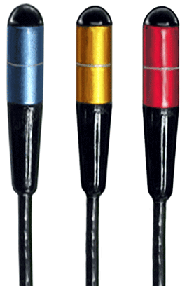|
| |
6-12 MeV Photon ISORAD-p Diode Detectors, SeeDOS Code 302120
15-25 MeV Photon ISORAD-p Diode Detectors, SeeDOS Code 303120
 |
|
The ISORAD-p™ is the only available cylindrical diode detector. The ISORAD-p™’s cylindrical design allows it to have nearly zero angular dependence along the axial axis, this makes it an ideal choice for tangential treatment cases where it is difficult to predict angle of incidence. ISORAD-p™’s are available in three photon energy ranges. Each energy range
uses a different buildup material designed to give a reading at dmax, therefore, no additional buildup is required. ISORAD-p™ reproducibility is > 0.55 for > 1cGy. Versatility and accuracy make the ISORAD-p™ one of Sun Nuclear’s best sellers.
|
NEW (April 2003) IMRT Mosfet Diode and Tabula Software, pdf brochure
Applications
ISORAD-p™ diode detectors can be used in any situation where a surface mounted diode is needed to verify patient dose.
ISORAD-p™ diode detectors are particularly useful for tangential treatments where the angle of incidence is difficult or impossible to predict.
ISORAD-p™ diode detectors can be used in conjunction
with some solid phantoms and the
IVD™ to verify complex treatment plans.
Energy Ranges – choosing the right ISORAD-p™
ISORAD-p™ detectors are offered in three photon energy ranges. A single energy compensted detector is also offered.
|
a) P/N 1161000-0 |
Compensated
|
| |
b) P/N 1162000-0 |
1-4 MV
|
| |
c) P/N 1163000-0 |
6-12 MV |
| |
d) P/N 1164000-0 |
15-25 MV |
|
Accuracy
The ISORAD-p™ offers exceptional accuracy for a diode detector.
When tested in air or in a cylindrical phantom for all the beams:
Variation in Axial response is only +/- 0.5% from 0° ~ 360°
When tested on top of 6 cm of solid or virtual water:
Variation in Axial response is still only +/- 0.5% from -60° ~ 60° for 6 MV
Variation in Axial response is only +/- 1.0% from -60° ~ 60° for 18 MV
Axial Directional response of ISORAD-p™ detectors on the Phantom

Technical comparison DIODES against the MOSFET detectors
DIODES vs. MOSFETs
Occasionally we receive inquiries about the pros and cons of DIODE detectors versus MOSFET detectors. We have also run across some confusing information regarding DIODE use versus MOSFET use. We have looked into this matter because it is understandable that a customer should choose whichever system is best.
Reproducibility turns out to be the biggest issue when comparing systems. As seen in the chart, which uses information from the manufacturer’s literature, the MOSFET detectors are much less reproducible than an ISORAD-p™ or QED™ diode detector. Reproducibility is defined as the percentage difference between consecutive measurements for the same radiation dose under the
same conditions. Furthermore, certain advantages for the MOSFET detector disappear if the detector is used for dmax measurements, which is usually the method of choice. For MOSFETs, buildup must be added in different amounts depending on energy to provide a reading at dmax. DIODES do not require this manual intervention. Once the buildup is added, certain MOSFET
advantages, such as no attenuation, low energy dependence, and "one" detector for multiple energies evaporate. If however the goal were to continue with no build up in order to realize these three objectives, this could be accomplished just as easily with a QED™ skin detector, which has
no inherent buildup and can be used in the same universal manner as a MOSFET. The MOSFETs also suffer from a very short lifetime, creep-up effect, signal fading, and a lack of real time reading.
Comparative Table
| |
ISORAD-p™ QED™
Diodes |
MOSFET detectors |
ADVANTAGE | |
TN-RD-20 |
TN-RD-19 | |
SENSITIVITY |
0.4nC/cGy |
1 mV/cGy
(.0000014nC/cGy) |
2.7 mV/cGy
(.0000038nC/cGy)
|
DIODES | |
REPRODUCIBILITY
(at 3 σ) |
>1 cGy |
< ± 0.5% |
3.5 cGy |
< 45% |
3.5 cGy |
< 16.1% |
DIODES | |
18.8 cGy |
< 22% |
18.8 cGy |
< 8.9% | |
100 cGy |
< 7.8% |
100 cGy |
< 3.5% | |
LIFETIME |
>10,000 Gy |
200 Gy |
70 Gy |
DIODES | |
CREEP-UP EFFECT |
None |
Up to 4 mV
4% for 100 cGy, 20% for 20 cGy |
DIODES | |
SIGNAL FADING |
N/A |
Up to 2% for 200cGy at 15 minutes, possibly greater for lower doses. |
DIODES | |
REAL-TIME |
Yes |
No. (First connect to reader, then irradiate, then connect to reader again, meanwhile avoid creep-up & fade) |
DIODES | |
DETECTOR SIZE (mm ^ 2) |
1.65 X 1.65 |
0.2 X 0.2 |
MOSFET | |
BUILD UP at dmax |
Inherent buildup included in diode |
Must add different buildup depending on energy. Adding buildup nullifies MOSFET claims to no attenuation, low energy dependence, and one detector for multiple energies. |
DIODES | |
DIRECTIONAL RESPONSE within 180˚ |
ISORAD-p™:
< 1% in air,
cylindrical,
or spherical
phantom |
< 3%, test conditions not specified |
DIODES |
Lifetime
As with any diode, ISORAD-p™ sensitivity will gradually change over time. This rate of change will depend on the energies used and the frequency of use. For normal use, plan on re-calibration once per year. Note that ISORAD-p™ life expectancy is not limited by radiation exposure – in fact the more an ISORAD-p™ is used the less its response characteristics will
change. Life expectancy is an issue of proper handling and care. Broken Co-Ax connectors and cables are the most common cause of failure. When handled under normal stress loads, the ISORAD-p™ should be expected to last > 1,000,000 cGy.
Construction
ISORAD-p™ construction is an advanced second-generation design. Build-up consists of a material that is best suited for each energy range.
| |
The
ISORAD-p™ series of detectors is intended to be used for the measurement of site specific patient radiation dose. The detectors are not waterproof.
General Specification
|
Effective detection area |
1.65 X 1.65 mm2 | |
Effective detection thickness |
50 um | |
Active volume |
0.14 mm3 | |
Preirradiation level |
Preirradiated to 10kGy at 10 MeV e- beam | |
Sensitivity |
40 nC/Gy | |
Impedance at 10 mV reverse bias |
200 Mohm at 24 0C | |
Cable diameter |
2.5 mm | |
Standard cable length |
3 meters | |
Cable connector |
BNC |
Specification for individual detector
|
|
Compensated |
1-4 MV
|
6-12 MV
|
15-25 MV | |
Buildup Material
|
Tin |
Aluminum |
Brass |
Tungsten | |
Total buildup (g/cm3) |
0.53 |
0.70 |
1.36 |
2.58 | |
*Axial response 1
(00~3600) |
99.5%~110.5% |
99.5%~100.5% |
99.5%~100.5% |
99.5%~100.5% |
**Axial response 2
(-600~+600) |
100.0%~102.5% |
100.0%~102.0% |
99.5%~101.0% |
99.5%~100.5% |
**Transverse response
(-600~+600) |
93.0%~100.0% |
99.0%~100.5% |
99.5%~102.5% |
97.0%~100.0% | |
Energy used for directional response |
Co-60 |
Co-60 |
6 MV |
18 MV | |
Detector diameter (mm) |
6.0 |
7.1 |
7.1 |
7.1 | |
COLOR |
BLACK |
BLUE |
GOLD |
RED | |
Model Number |
negative output |
1161000-0 |
1162000-0 |
1163000-0 |
1164000-0 | |
positive output |
1161000-1 |
1162000-1 |
1163000-1 |
1164000-1 |
* Tested in air, scatter conditions are constant.
** Tested on a plastic phantom. |

Features
ISORAD-p™ is the only available diode with
Cylindrical Symmetry, angular corrections are not required.
Advanced second generation p-type die design is accurate and responsive.
Compatibility with any diode based dosimetry system.
Reproducibility is excellent at >0.5% for 1cGy.
Intelligent pricing.
A pdf ISORAD Photon Diode Detector brochure is available, please click here If you are interested in any of the products mentioned here, please complete a Quotation Request Form or an
Enquiry Form so that we may promptly respond to your detailed request. |
TOP OF PAGE
Please contact Colin Walters at cwalters@seedos.com if you would like further information or you have questions
or comments about this web site.
SeeDOS Ltd, 26, The Maltings, Leighton Buzzard, Bedfordshire LU7 4BS, United Kingdom
Tel: +44 1525 850 670 • Fax: +44 1525 850 685
|
|
